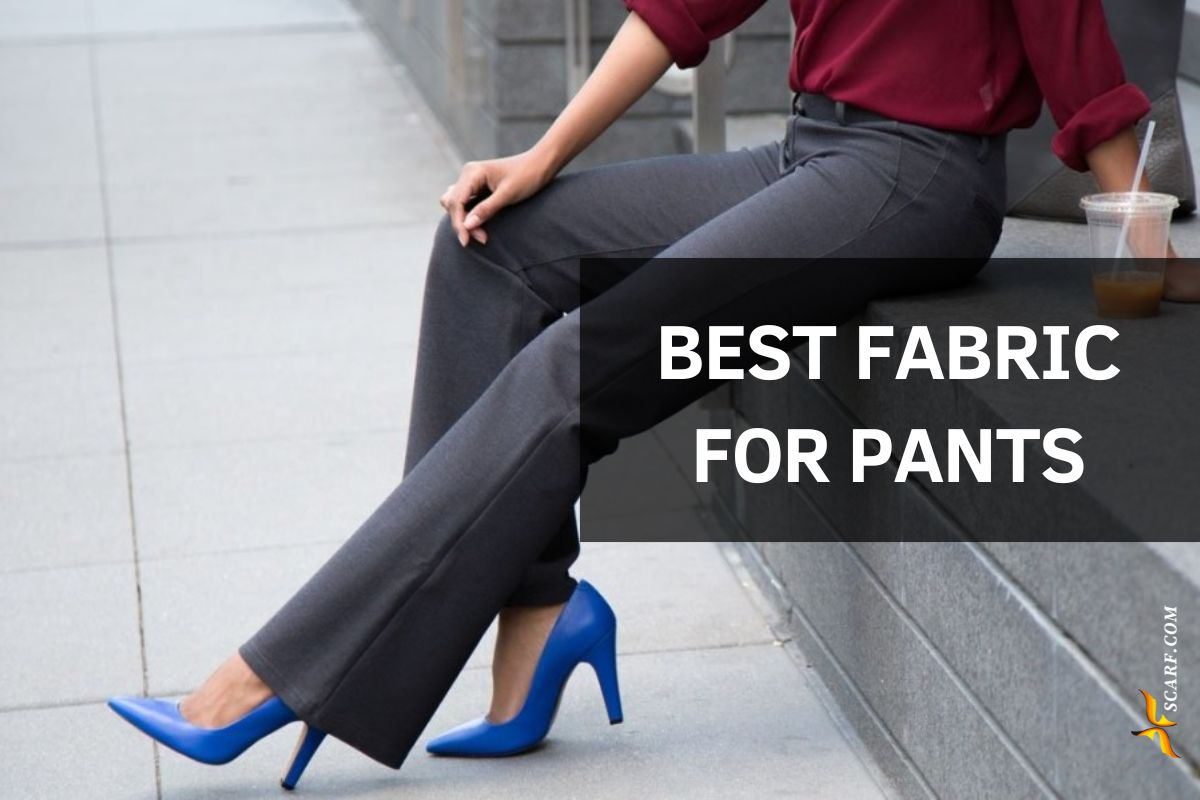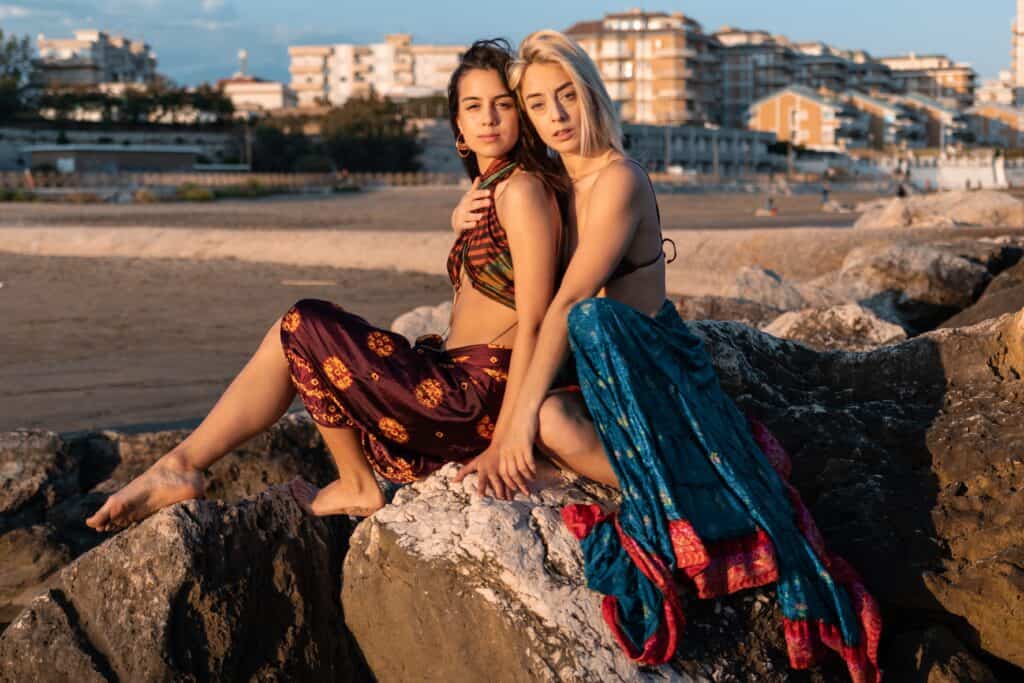What is the best fabric for pants? How to choose the fabrics for pants? The trousers are a staple in almost every style. Trousers are the mainstay of any wardrobe and frequently wear. It’s important to choose the right fabric when choosing trousers. The wrong fabric will make your pants look bad or not last.
Don’t worry, follow me, I will tell you the best fabric for pants, according to different environments and temperatures. And how much fabric do you need.
How to choose fabric for pants?
Breathability
A good breathability will keep you dry and prevent excessive sweating. It also helps to avoid discomfort. Materials with good breathability are also useful for summer sportswear. They can reduce the chances of bacteria growth and odors.
Comfort
All clothing types should be comfortable. It is possible to create a relaxing experience by choosing materials that are soft and do not irritate. Pants should also allow for unrestricted movements, balancing warmth with flexibility. It will cause discomfort when worn.
Durability and wrinkle resistance
Pants should be stronger and more durable than other garments because they are worn by people who walk and move around. If wrinkles are visible quickly, this can affect the user’s experience and their trust in a brand.
Polyester, for example, is a fabric that has a built-in elasticity and resistance to wrinkles. Chemical agents such as wrinkle repellents or shrinkage inhibitors can be used to enhance the fabric’s wrinkle resistance. You can also add special coatings on the fabric to enhance its properties.
GSM
How many yards of fabric for pants? The fabric is heavier and warmer when the GSM (or oz) is higher. The season is the main factor in determining GSM. Pants for spring and fall are usually lighter with fabrics like polyester or cotton. Winter fabrics, such as corduroys, require between 300 GSM and 350 GSM.
You can get a better idea of the type of trousers each fabric would work best for by feeling it in a fabric store. You can still find some great fabrics online. You should always check the weight when you are buying fabric online to make trousers.
Weights are usually listed as grams per square meter or ounces/square yard. Remember that the higher the GSM, or the more ounces the fabric is going to be.
| Type of Pants | Fabric Width | Fabric Needed |
|---|---|---|
| Simple Adult Pants | 60 inches (150 cm) | 2 to 2.5 yards |
| 45 inches (114 cm) | 2.5 to 3 yards | |
| Tailored/ Detailed Pants | 60 inches (150 cm) | 2.5 to 3 yards |
| 45 inches (114 cm) | 3 to 3.5 yards | |
| Children’s Pants | 60 inches (150 cm) | 1 to 1.5 yards |
| 45 inches (114 cm) | 1.5 to 2 yards |
- Larger Sizes: Add an additional 0.5 to 1 yard of fabric.
- Design Details: Pants with wide legs, high waists, or additional design details (like pleats, pockets, or cuffs) will require more fabric.
- Pattern Matching: Buy extra fabric to account for pattern matching, mistakes, or shrinkage after washing.
Types of fabric for pants
Here I recommend some good types of fabrics for pants, let’s take a look.
Cotton
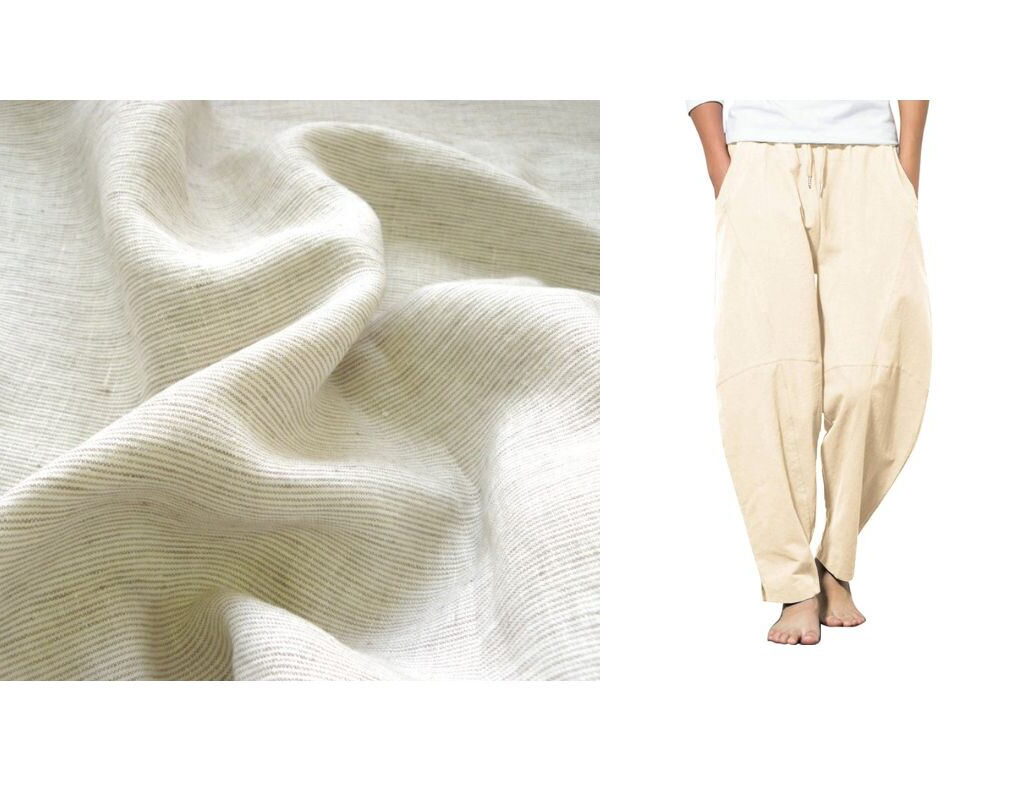

Cotton is a natural material that is lightweight, flexible, breathable and comfortable. Cotton is a versatile fabric that can be used to create pants for any style or season. Because of its moisture-wicking qualities, it’s often blended with other fabrics for sportswear such as yoga pants and cycling briefs.
Cotton is also less likely to cause irritation of the skin, it is often used for children’s trousers.
Denim
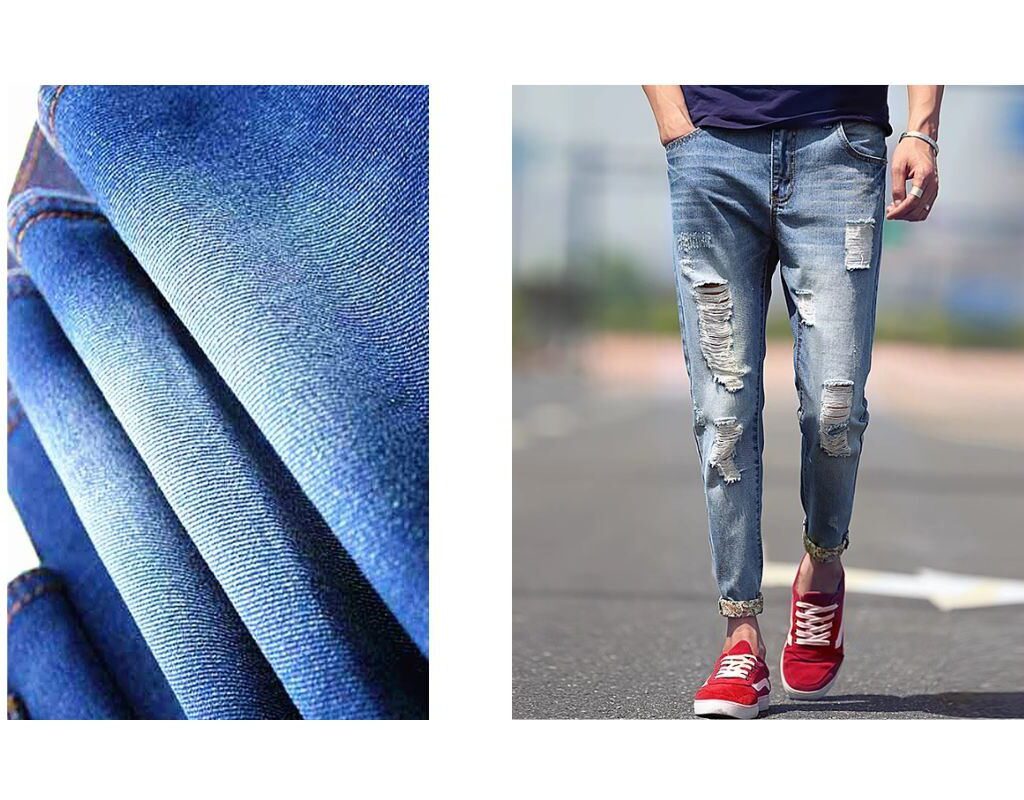

Denim is one of the most popular twill fabrics and is perfect for casual, everyday trousers. The fabric is typically thick, heavy, or mid-weight. It’s durable and comfortable.
Linen
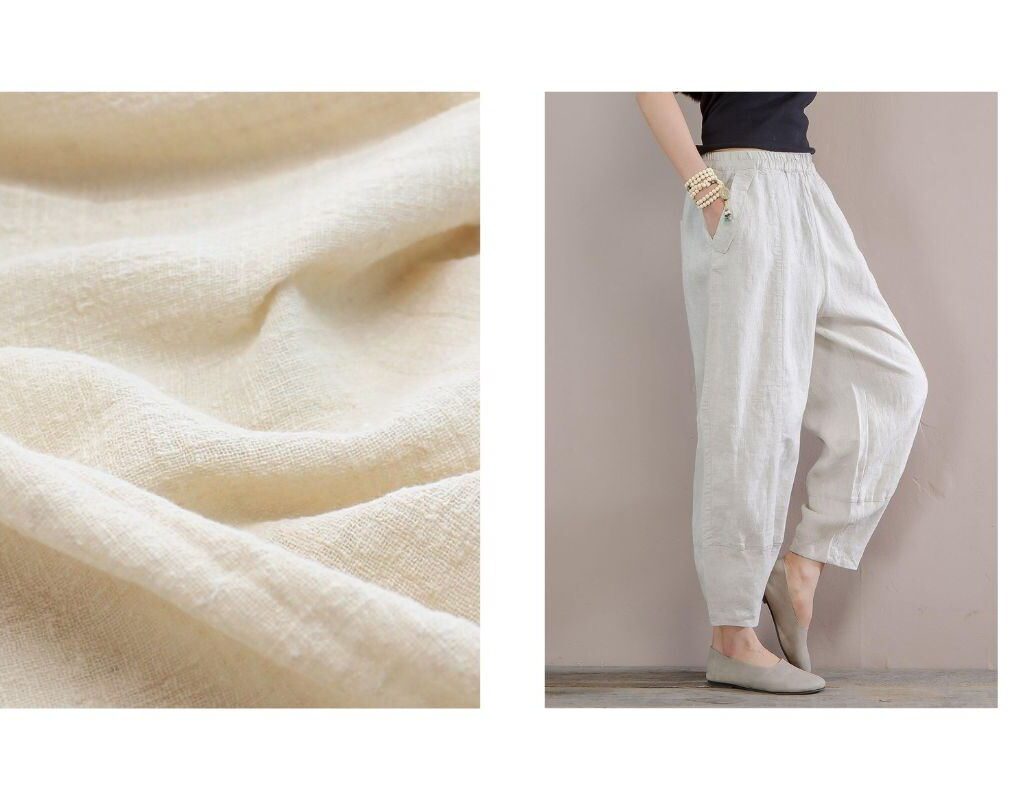

Linen fabric has a high colorfastness and is very easy to dye. It is also resistant to dust and static electricity. But linen is susceptible to wrinkles and deformation.
Uses: Summer pants, casual wear, beachwear.
Linen/cotton blend
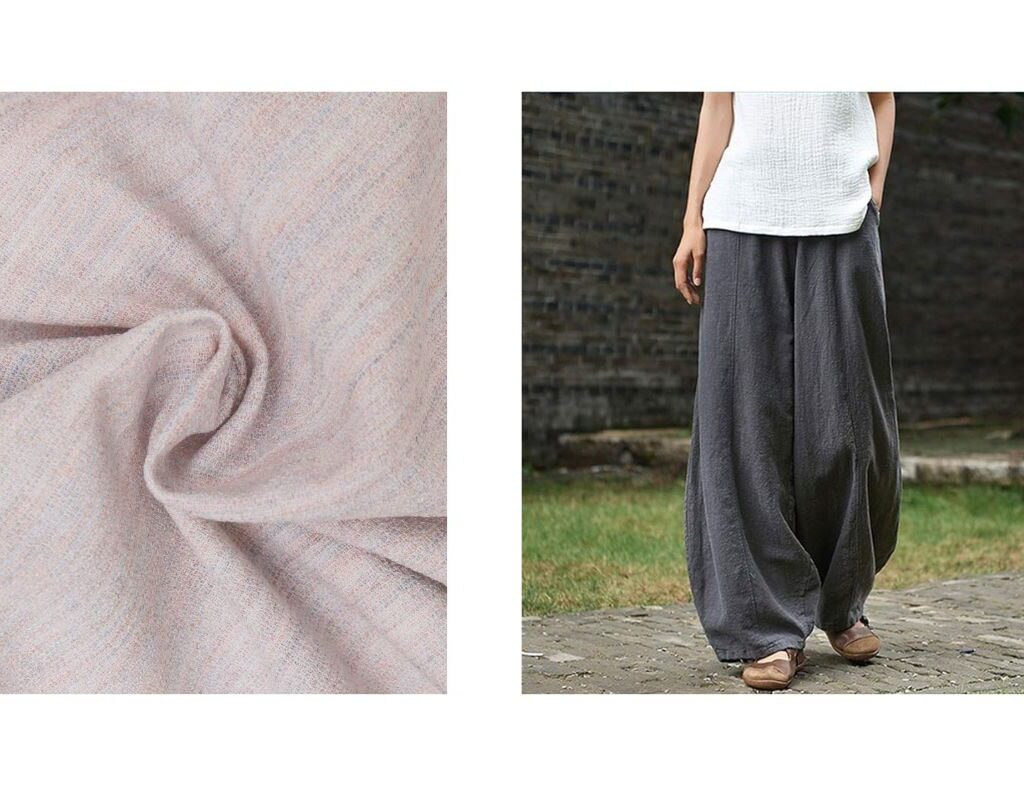

You love the comfort of linen but you hate the wrinkles. You may want your trousers to have a more relaxed, less worn-in look. Consider a linen/cotton mix. Cotton is a little softer and wrinkles less than linen.
Silk
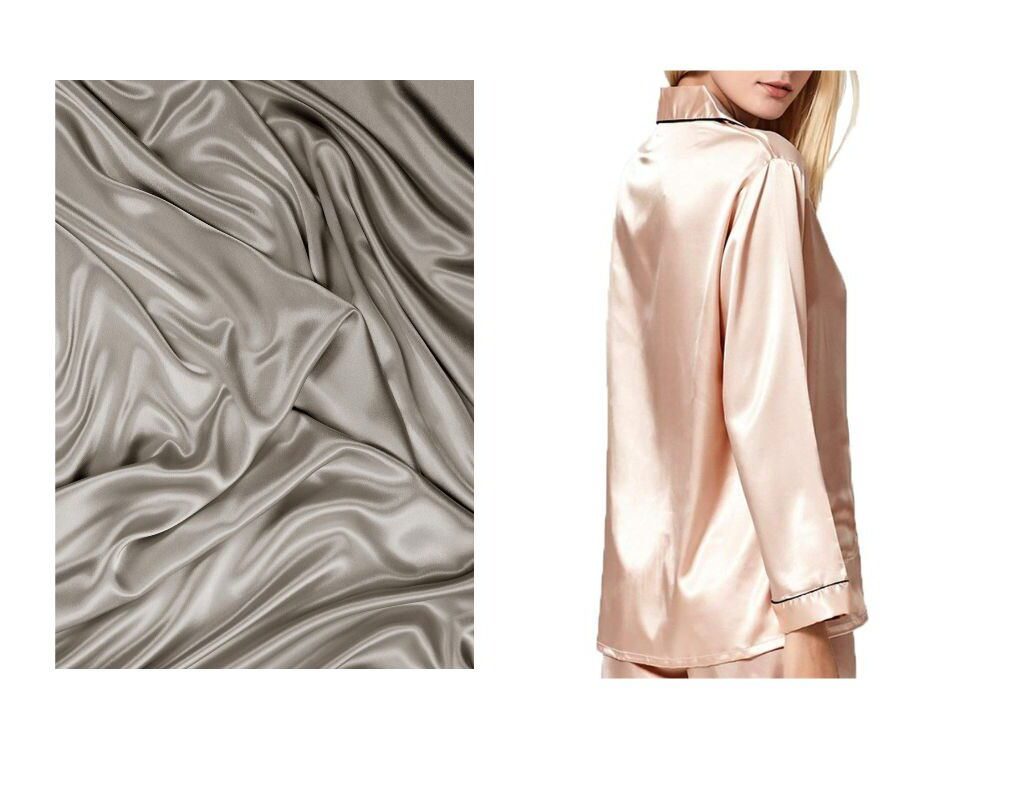

Silk is lightweight, has a smooth and soft touch, and provides exceptional comfort. Summer is the perfect time to make wide-leg pants. The unique sheen of this fabric and its luxurious feel make it a great choice for premium trousers. But this type of fabric is not durable.
Silk fibers are hygroscopic, which means they can absorb up to 40% of the weight in water and not show any moisture. This is why you will never feel damp if you perspire. It’s suitable fabric for pajama pants.
Silk fibers are anti-allergic and suitable for sensitive skin.
Polyester
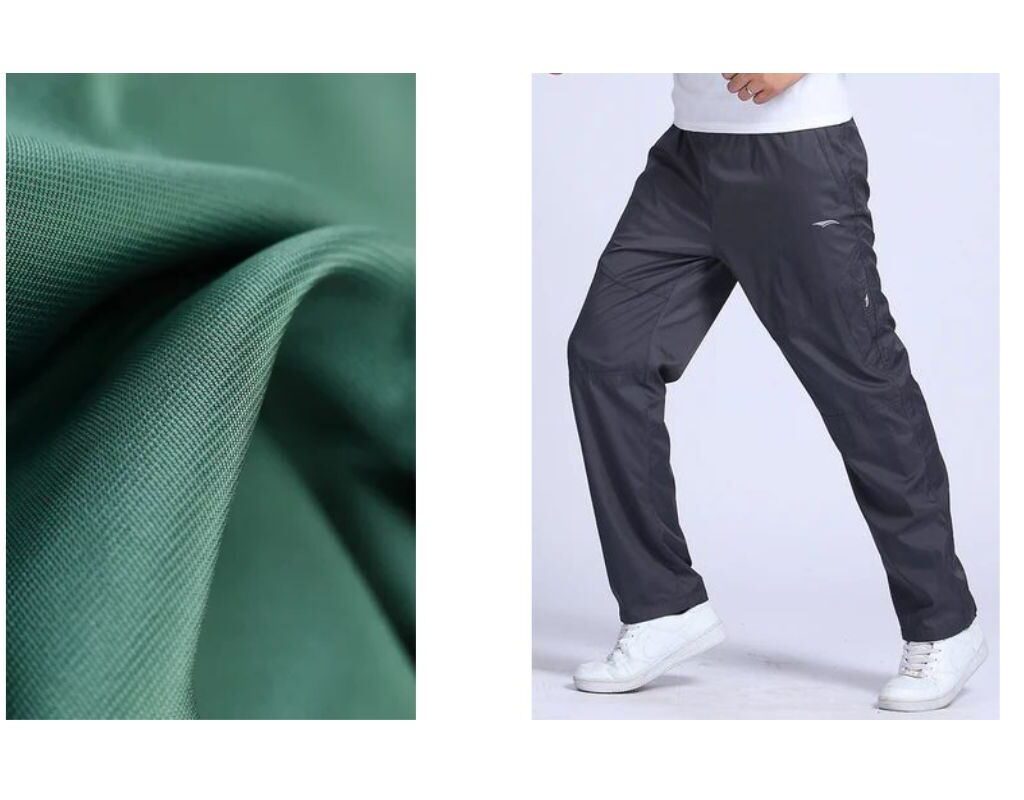

The most common fabric for pants and trousers is polyester fiber. Polyester is a material that has high abrasion and wrinkle resistance. Its dyed colors also are vibrant and do not fade easily. Polyester is used to make many types of pants including cargo pants, travel pants, activewear and work pants.
Pure polyester fibers are not breathable and can generate static electricity. This material can cause allergic reactions or skin irritation. Most manufacturers mix it with other materials, such as cotton, spandex and other fibers, to create pants.
Wool
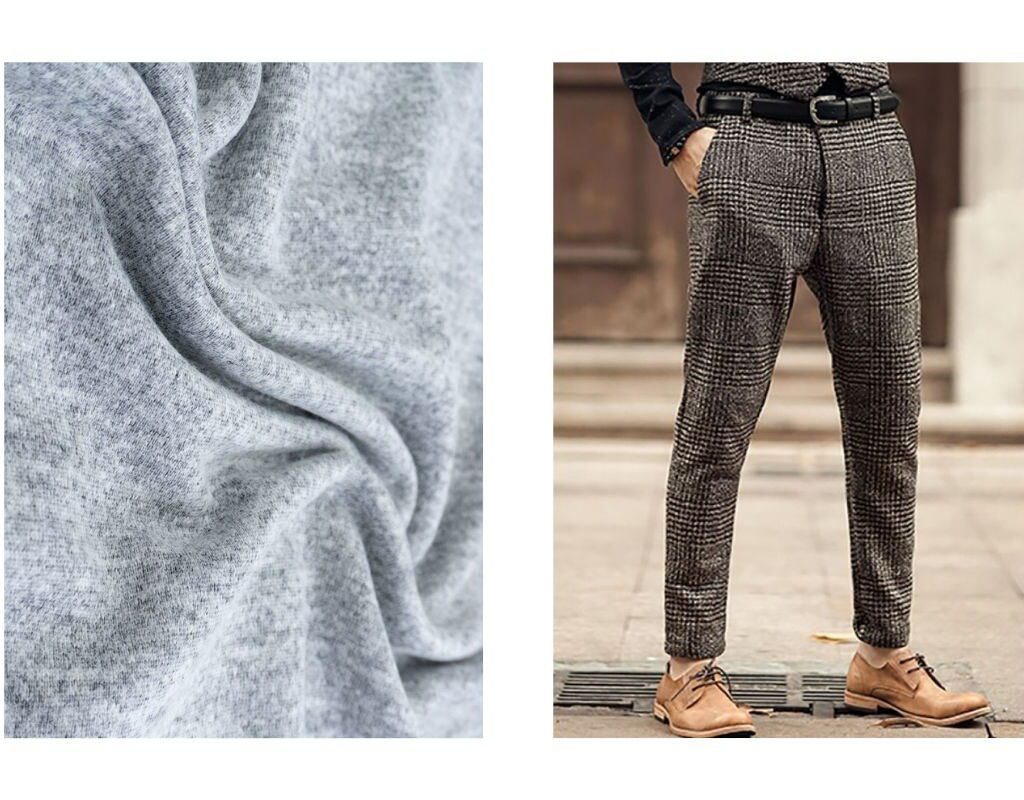

Wool pants are popular due to their excellent moisture-absorbing and warmth properties. Wool trousers and tweeds are commonly used for casual and business styles. Wool may cause allergies.
Canvas
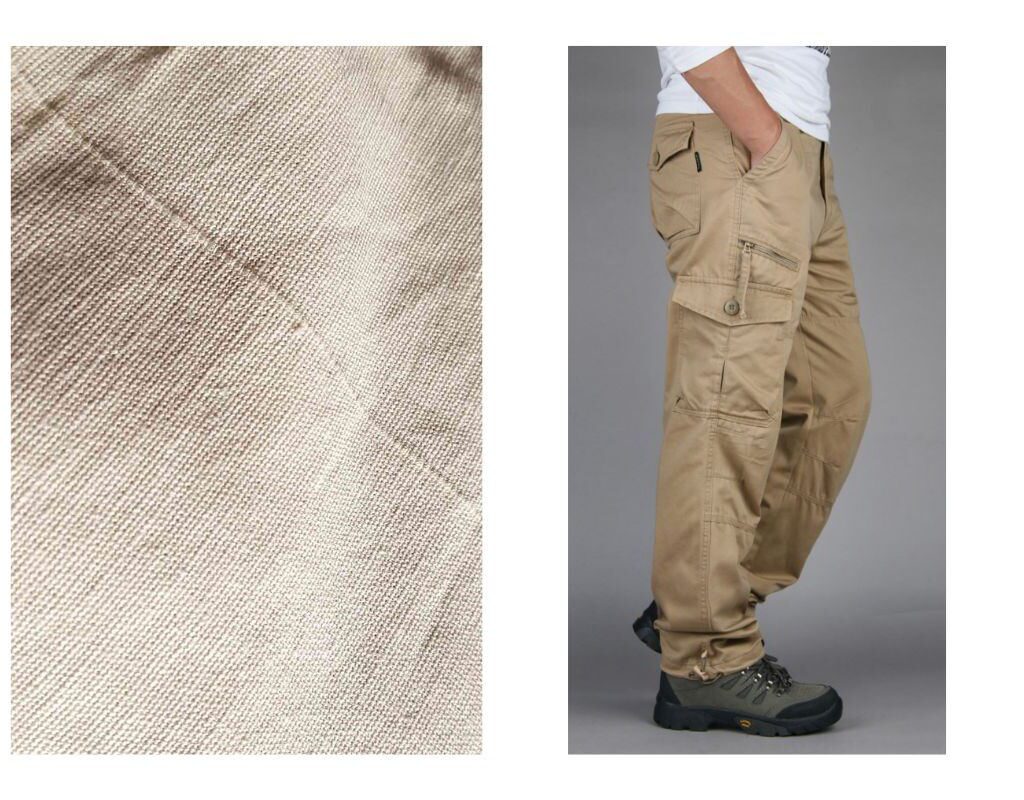

Canvas is tough, durable and usually made of cotton fibers. The fabric is durable, strong, and resistant to wind and water. Fabrics of this type are ideal for outdoor environments and active lifestyles. It is therefore often used to make casual pants, outdoor pants, and work pants.
It is not recommended for situations that require high breathability or hot weather.
Corduroy
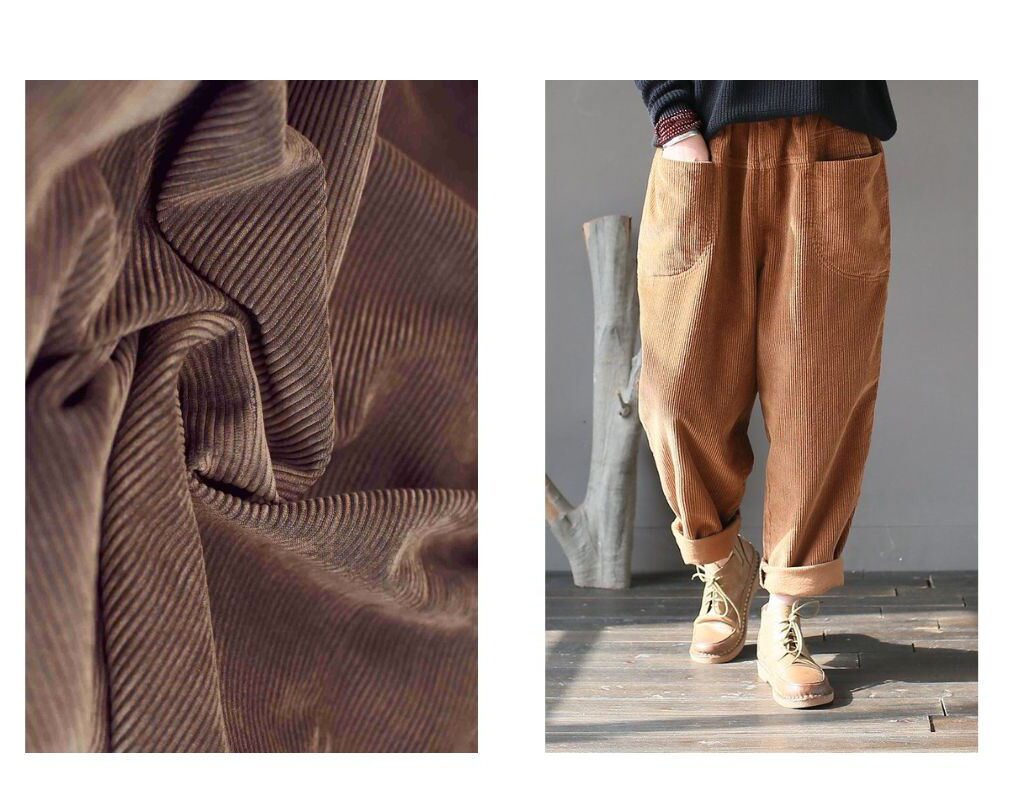

Corduroy is also a classic fabric for trousers. The fabric is perfect for trousers due to its uniqueness and durability. Corduroy, a high-density synthetic fabric, is excellent for insulation.
Rayon
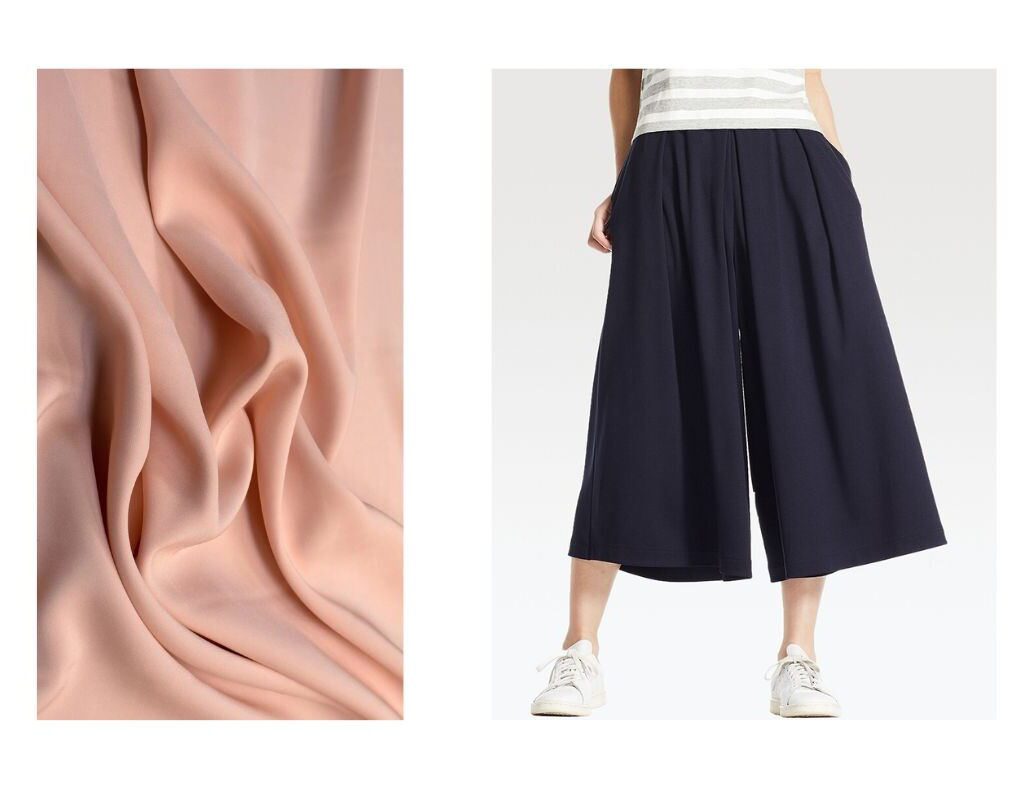

Rayon is a regenerated cellulose fiber made by chemically treating natural cellulose (usually from wood pulp or cotton fibers). Rayon has a soft, smooth texture and looks and feels similar to silk, but at a relatively low cost.
Velvet
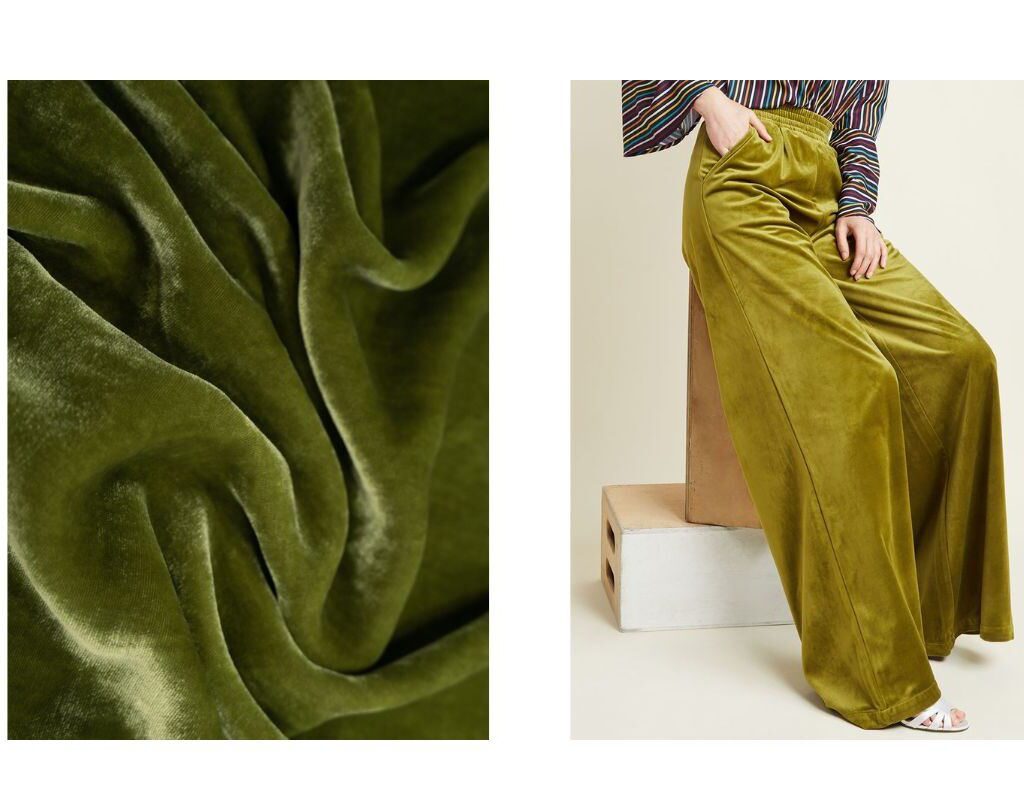

Velvet is a luxurious fabric known for its soft texture, rich color and gorgeous appearance. Avoid heavy pressure when storing to avoid flattening the fluff. It is best to hang it up or fold it lightly.
Uses: Dress pants, evening wear, special occasions
| Fabric Type | Characteristics | Uses |
|---|---|---|
| Cotton | Breathable, comfortable, easy to care for | Casual pants, chinos, summer wear |
| Denim | Durable, slightly stretchy | Jeans, casual wear |
| Linen | Light, breathable, moisture-wicking | Summer pants, beachwear |
| Wool | Warm, insulating, wrinkle-resistant | Dress pants, suits, winter wear |
| Polyester | Durable, wrinkle-resistant | Work pants, uniforms |
| Rayon | Soft, drapes well, breathable | Dress pants, palazzo pants |
| Twill | Durable, diagonal weave pattern | Chinos, khakis, work pants |
| Silk | Luxurious, smooth, breathable | Dress pants, formal wear |
| Spandex/Elastane Blends | High stretch, flexible | Activewear, leggings |
| Corduroy | Soft, warm, ribbed texture | Casual pants, winter wear |
| Gabardine | Durable, tightly woven | Dress pants, suits, uniforms |
| Canvas | Heavyweight, sturdy | Work pants, outdoor wear |
| Velvet | Soft, luxurious texture | Dress pants, evening wear |
FAQ
How many yards of fabric for pants?
For adult straight-leg pants:
- 45-inch wide fabric: 2.5 to 3 yards.
- 60-inch wide fabric: 2 to 2.5 yards.
For wide-leg pants:
- 45-inch wide fabric: 3 to 3.5 yards.
- 60-inch wide fabric: 2.5 to 3 yards.
Children’s pants:
- 45-inch wide fabric: 1 to 1.5 yards.
- 60-inch wide fabric: 0.75 to 1 yard.
What is fabric for pajama pants?
- Cotton: Soft, breathable, and easy to care for.
- Flannel: Warm and cozy, great for colder weather.
- Jersey Knit: Stretchy and comfortable, suitable for all seasons.
- Fleece: Very warm and soft, best for winter.
- Satin or Silk: Smooth and luxurious.
How much fabric for pajama pants?
Adults:
- 45-inch wide fabric: 2.5 to 3 yards
- 60-inch wide fabric: 2 to 2.5 yards
Children:
- 45-inch wide fabric: 1 to 1.5 yards
- 60-inch wide fabric: 0.75 to 1 yard
What fabric is best for stretchy pants?
For stretchy pants, the best fabric choice is spandex, also known as Lycra or elastane, due to its exceptional stretch and recovery properties. Often blended with other fibers such as cotton, polyester, or nylon, spandex adds flexibility and comfort, making it ideal for activewear, leggings, and fitted garments. This fabric ensures a snug fit that moves with the body, providing both comfort and functionality.
Which fabric is best for formal pants?
The best fabric for formal pants is wool. Wool is highly regarded for its durability, breathability, and natural wrinkle resistance, making it ideal for maintaining a polished and professional appearance. Additionally, wool blends, such as wool with a bit of polyester or elastane, can offer added comfort and durability while maintaining a formal look.
What fabric to use in pants lining?
- Silk: Luxurious, smooth, and breathable.
- Polyester: Durable, affordable, and wrinkle-resistant.
- Bemberg (Cupro): Breathable, smooth, and feels like silk but is more affordable.
- Acetate: Smooth and drapes well, often used in high-end garments.
- Cotton: Breathable and comfortable, good for casual pants.
What fabric lasts longest outside?
Synthetic fibers like polyester, nylon, and acrylic last longest outside due to their durability, resistance to weather, and UV protection. They withstand sunlight, moisture, and temperature changes well, making them ideal for outdoor use in clothing, furniture, and gear.
What is the most breathable fabric?
Cotton is widely regarded as the most breathable fabric due to its natural fibers, which allow air to circulate freely, keeping the body cool and comfortable. Additionally, linen and bamboo are also highly breathable options, known for their moisture-wicking properties and ability to keep the skin dry in hot and humid conditions. Wool and silk, although less commonly associated with breathability, can also be breathable when woven in lightweight and loose constructions. Overall, natural fibers tend to be more breathable than synthetic materials.
What fabric doesn’t show sweat?
Moisture-wicking synthetic fabrics such as polyester, nylon, and polypropylene are excellent choices for clothing that doesn’t show sweat. These fabrics draw moisture away from the skin and quickly evaporate it, preventing sweat from accumulating and becoming visible on the fabric’s surface. Additionally, blended fabrics that combine natural fibers like cotton with synthetic fibers can also offer sweat-wicking properties while maintaining a more natural feel.
Choose an excellent manufacturer
Want to customize a special fabric for your pants? Choose us. We can provide you with a variety of fabric options, super low prices, and super good quality. Now, contact us to start business!

